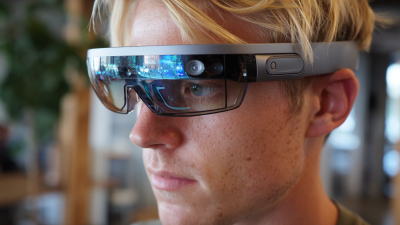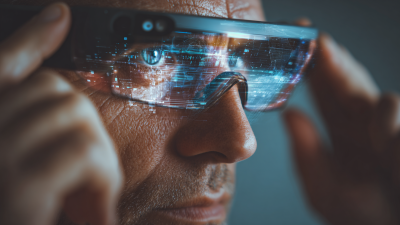 +86-13613020876
+86-13613020876



The rapidly evolving landscape of consumer electronics is demonstrating a notable shift towards innovative wearables, with Smart Eye Glasses emerging as a potential game changer in both functionality and market appeal. According to a recent report by MarketsandMarkets, the global smart glasses market is projected to reach USD 22.4 billion by 2025, growing at a compound annual growth rate (CAGR) of 32.2% from 2020. The upcoming 138th China Import and Export Fair serves as a pivotal platform to explore this burgeoning market trend, showcasing cutting-edge advancements and varied applications of Smart Eye Glasses across sectors such as healthcare, retail, and education. As manufacturers and brands converge in Guangzhou, they will not only unveil their latest technological innovations but also engage in critical discussions on consumer preferences and market dynamics that could shape the future of wearable technology.

The market for smart eyewear is set to experience significant growth, with projections indicating the global market size will surge from $130.23 billion in 2025 to $214.58 billion by 2032, driven by a CAGR of 7.4%. Notably, the AI smart glasses segment is anticipated to reach an impressive sales volume of 5.7 million units in 2025, reflecting a staggering year-over-year growth of 110%. This upswing follows the successful launch of innovative products that have captured consumer interest, particularly as advanced technologies like AI and augmented reality (AR) converge with eyewear.

As reported by IDC, the Chinese smart eyewear market is on an accelerated path, having recorded a remarkable year-over-year growth rate of 145.5% in the second quarter of 2025 alone. Such growth underscores the expanding market potential and rising consumer acceptance of smart eyewear technology. Improved manufacturing techniques and a diverse range of applications in everyday life are key drivers behind this trend, positioning smart eyewear as a pivotal segment in the broader consumer electronics sector.
Tips: When considering investment in smart eyewear, analyze the latest trends and consumer preferences. Staying updated with market insights will ensure informed decisions and opportunities in this booming industry. Additionally, pay attention to tech advancements, as they can significantly impact consumer demand and market dynamics.
The rapid evolution of technology has led to groundbreaking innovations in smart eye glasses, significantly shaping market trends ahead of the 2025 China Import and Export Fair. Key advancements in display technology, such as microLED and augmented reality (AR) integration, have enabled these devices to become more lightweight and energy-efficient, appealing to both consumers and enterprises. These innovations facilitate real-time information overlay, enhancing user interaction and engagement, which has become essential in both recreational and professional settings.
Moreover, improvements in battery life and connectivity options, including 5G integration, have made smart eye glasses increasingly viable for daily use. Users can expect longer durations of functionality without the fear of battery drain, while seamless connectivity opens up a world of applications, from navigation assistance to remote collaboration in business environments. As the market for smart eye glasses continues to expand, these technological innovations will drive consumer demand, making the upcoming fair a focal point for industry stakeholders to showcase cutting-edge products and foster potential partnerships.
This chart illustrates the projected market demand for smart eye glasses from 2020 to 2025. The steady increase indicates significant technological innovations and growing consumer interest in this product category.
As we approach the 2025 China Import and Export Fair, the interest in smart eye glasses is escalating, driven by evolving consumer preferences and technological advancements. A recent report by Research and Markets predicts that the global smart glasses market is expected to reach $11.46 billion by 2025, with significant contributions from China. Consumers are showing increased demand for features such as augmented reality (AR) capabilities, hands-free operation, and seamless connectivity with other devices.
Tips: When considering smart eye glasses, look for models that offer long battery life and lightweight designs for comfort during prolonged use.
Moreover, expectations for smart eye glasses are also shifting. According to a survey conducted by Statista, 62% of consumers anticipate enhancements in display quality and interactive features by 2025. User experience will be paramount, with consumers favoring intuitive interfaces and customizable designs. As the market evolves, manufacturers must be attentive to these consumer insights to create products that not only meet functional needs but also resonate emotionally with users.
Tips: Paying attention to customer reviews can provide insights into the practical benefits and drawbacks of various smart eye glasses available in the market.
The competitive landscape of the smart eye glasses industry is shaped by various technologies and applications, particularly focusing on dynamic vision sensors (DVS) and event-based vision sensors (EVS). These technologies offer unique advantages in areas such as automotive mobility, industrial automation, and consumer electronics. As various sectors integrate advanced visual capabilities, the market share among major players is evolving, driven by technological innovations and consumer demand for enhanced features and functionalities.
Applications such as wearable AI and augmented reality (AR) continue to gain traction, with significant growth anticipated through 2032. The wearables market is projected to reach a staggering $260.3 billion by 2032, highlighting the increasing interest in devices that combine convenience and cutting-edge technology. As players jockey for position in this promising market, understanding the differentiation in sensor types and resolutions will be crucial for success. The rise of smart glasses serves not only as a testament to innovation but also signals a new era in how consumers interact with their environments, showcasing potential use cases that extend far beyond traditional functionalities.

As the 2025 China Import and Export Fair approaches, the regulatory environment surrounding smart eye glasses is poised to significantly influence market dynamics. The Chinese government has been actively shaping policies that affect technology integration and consumer electronics, particularly in wearable devices. According to a report by the International Data Corporation (IDC), the demand for smart glasses in China is projected to grow at a compound annual growth rate (CAGR) of 15% from 2022 to 2025, partly fueled by favorable regulations that encourage innovation and investment in augmented reality.
In addition, recent changes to data privacy laws and electronic waste management regulations are set to impact the smart eye glasses market. A 2023 analysis by MarketsandMarkets highlights that compliance with these evolving regulations could drive up production costs but will ultimately lead to improved product safety and consumer confidence. Manufacturers are expected to optimize their processes to meet these standards, ensuring that the smart eye glasses produced are not only technologically advanced but also socially responsible, aligning with global sustainability trends. This regulatory landscape will play a crucial role in shaping the competitive landscape for smart eye glasses in China by 2025.






